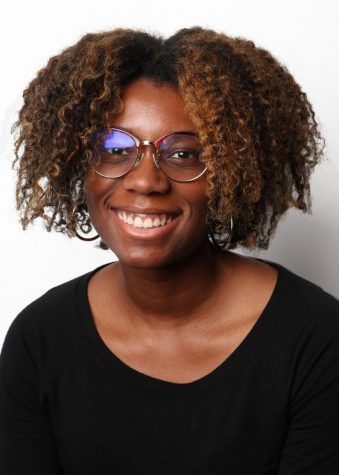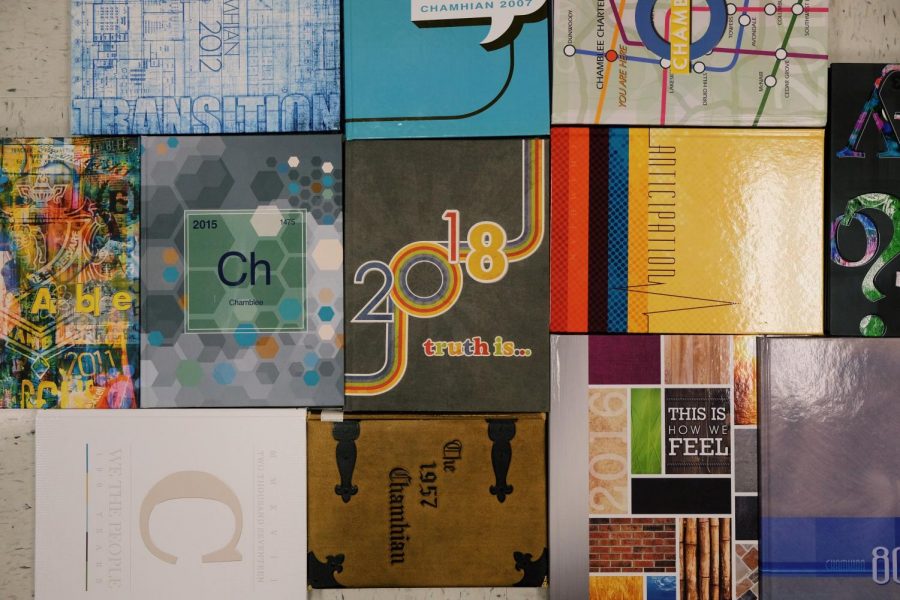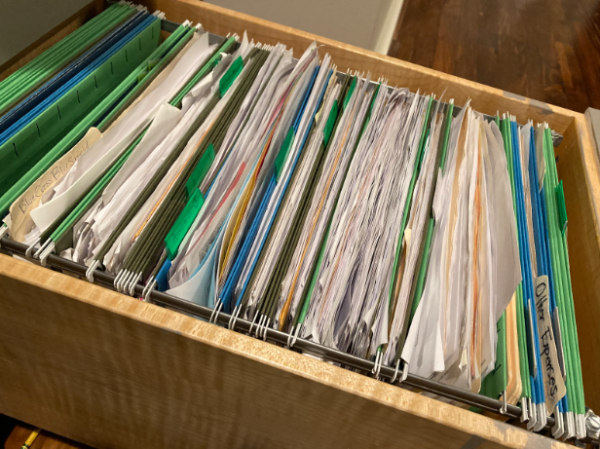A Snapshot on Yearbook: How Chamblee’s Yearly Memento is Made
Yearbook staffers are the undercurrent of the school. They work for months to create a comprehensive book that the student body and teachers will enjoy and treasure for years to come. It can be hard work but is well worth the reward.
Meet the Yearbook Staff
In the yearbook class, there are different levels of staffers that have varying responsibilities.
English teacher and yearbook adviser Amy Branca is in charge of the organization of the physical yearbook. She also manages the communication with Walsworth, the yearbook printing service, and Cady Studios, the company that takes the yearbook photos, along with all other administrative activities.
Grace Schmertz is the editor in chief. She grades all the editors. All spreads are sent to her before Branca for approval. The eight editors are in charge of a specific grade or section. They do everything from interviewing to taking photos to designing layouts. Under them are staffers who are in yearbook one and yearbook two.
“Yearbook two, in this case, are people who are in their second year of yearbook and aren’t an editor,” said senior editor Isabel Yap. “Really everyone does everything, which is the unique thing about our staff because apparently other staffs aren’t set up that way. The only division in work is probably between yearbook one people and everyone else. Since they are new to the staff, they are still learning the ropes so we gradually give them more to do and help them learn along the way.”
Branca claims yearbook staffers must be well rounded in order to be successful.
“You have to know how to be good at everything,” said Branca. “So that means layout and design, teaching them the rules for how you lay things out so they don’t look like junk. They have to be able to write. They have to be able to conduct an interview. They have to be able to take good photographs. They have to be able to edit the photographs and crop them correctly. They’ve got to come up with witty headlines and subheadlines and caption ideas for every section of everything.”
The work on the yearbook is divided into sections.
“Each section has three or four people in it who are underneath an editor,” said senior photo editor James Stanfield. “There’s a freshmen section, sophomore, junior, senior, sports section, and as well as a faculty section, and all of these come together to make up the yearbook. We have different responsibilities based on the section we are in. Some people spill into other things like I’m faculty, but I help out with taking pictures. If one section is doing really good in terms of workload then we can send them to another section to help out. Everyone does a little bit of every section.”
Creating the Yearbook
Work on the yearbook starts the previous year. Layout designs and themes are generated during a summer workshop.
“We start the year before. That’s when we start planning out,” said Stanfield. “We already have our theme set up for next year. We do a little bit of prep work the year before like designing spreads and everything. Over the summer we have a workshop during June, which is a 3-day workshop. We grind out a bunch of our spreads and we plan out events we want to cover, ways we want to design the yearbook — all these things we have them planned out then. That is also when we start to set our deadlines.”
Certain topics are covered annually, but the staff tries to keep the yearbook new and unique by changing up other spreads.
“Whatever is interesting, whatever is happening in the year we cover,” said Stanfield. “We try to keep everything unique. The things that we hate talking about are just the typical things that come up every year, but if there is something unique happening this year, even if it’s a reiteration of something that has happened in the past, we are going to put it in.”
The yearbook always is defined by a theme. Ideas for the theme can come from anywhere and are delineated the year before.
“The theme is decided the year before, and Ms. Branca usually gets the ideas going,” said Yap. “But the process of deciding upon a theme does change, like this year Ms. Branca found a page in a magazine and was like, ‘This is our theme and cover, guys.’ And it worked out great.”
Aside from keeping the theme different each year, yearbook staff members do a section on student life, which varies based on student interest.
“There is a whole section called student life, and that changes every year,” said Branca. “Sometimes [the yearbook staff covers] jobs, sometimes they do summer, sometimes they do bumper stickers on your car that expresses who you are, sometimes they do pets, sometimes they do religious differences. They come up with anything they want. It’s kind of based on what people are talking about at the time.”
The Struggles of a Yearbook Staffer
Laying out the yearbook can be stressful and hard to learn for first years.
“The layout is a lot harder than what people think and a lot more complex,” said first-year staffer junior Jaely Chavez. “We have to know font sizes [and] which ones to use so it flows with the theme. It’s the little things and very detailed stuff that matter. For the pictures, we have to know how to lay them out correctly so it’s aesthetically pleasing to the eye.”
Working under such strict deadlines only adds to the stress.
“It’s incredibly stressful,” said Stanfield. “We keep tight deadlines, and when you have Ms. Branca as your editor, she is about as strict as it gets.”
Editors have extra pressure on them, having to lead and check for all mistakes within the section.
“The most difficult part for me this year was running my section,” said Yap. “As an editor, if there is a problem with your spread, it is your fault and no one else’s because you control everything that goes on there before Ms. Branca sees it. That pressure really freaked me out the first month or so.”
First-year staff members are exposed to various new elements, one of which is trying to engage with interviewees.
“The most difficult part is interviewing people because people sometimes when you interview them, [they] are very dry,” said Chavez. “They don’t really talk to you, and it doesn’t feel like a conversation. Now [that] I know what people are looking for, you can’t give them a bland story or idea.”
First years are slowly introduced to new skills and then go on to working on their own.
“There is definitely a learning curve,” said Stanfield. “We work pretty hard to expose the newer kids to doing work on their own pretty early, like we don’t want anyone to get stuck up a creek when they do their supplement, which is essentially the final test for a first-year yearbook member. During the spring, they’re each assigned their own spread, and they have to do it from start to finish.”
The Accomplishments of a Yearbook Staffer
As stressful as yearbook can be sometimes, it is definitely a highlight of high school for staffers.
“My favorite part is […] working with everyone in the staff,” said Yap. “I have made some amazing friends the last two years I have been a staff member. […] It is so gratifying to see all our hard work in one beautiful book.”
For editor Isabel Rohrer, finishing and giving the yearbook to the school is rewarding.
“My favorite part is seeing the progress we make overtime and creating something that so many people look at and get to enjoy,” said Rohrer. “We aren’t just doing it for ourselves.”
According to Branca, the purpose of the yearbook is to serve as a memento.
“Our job is to make sure that we represent all aspects of the school and in a relatively positive light, [which is] not saying that we can’t have things that are controversial,” said Branca. “We did a page on being a teen mother a number of years ago and stuff that comes with that when you come to school and have to take care of a toddler. So we’re not afraid of, you know, getting to the cutting edge. Our job is so that [when] you look at it this year, […] you’re like, ‘Oh, look, there I am.’ But it’s not really about now. It’s about in 10 years and 20 and 30 years when your kids are asking you what high school was like, and you go get the yearbook out.”
The Chamblee yearbook is judged each year by a panel of judges and has won awards on multiple occasions.
“There are professional organizations like the Columbia Scholastic Press Association, National Scholastic Press Association, and Georgia Scholastic Press,” said Branca. “They do critiques on newspapers, yearbook, and literary magazines. So you have an application that you fill out. So you send it off to them and you get a person that goes through it with a style guide and judges it. And then send you back the critique and then there are different awards for the top winner. We have an award for every year since 2008.”
The Aftermath of the Yearbook’s Release
Many students comment on the price of the yearbook and senior ads, but most do not know that producing the yearbook costs $72,646.
“What they don’t see at all is that I have to do all the finances behind the scenes, taking all the money for the senior ads and for the payments for the yearbook,” said Branca. “For financials, people want to know how much we have to pay to get the yearbook printed, and I don’t think anyone thinks it’s this number. This is why the yearbook costs what it costs and the senior year ads cost what they cost. We have to raise this money, and we have a product.”
Every piece of work comes with many critiques, both positive and negative. The negative comments and remarks that the yearbook staffers receive can be very difficult, especially after they have given the yearbook their all.
“We’re happy to get [the yearbook], […] but between the time we get it in the building and the time we give it out, that’s the happiest [the staffers are] going to be,” said Branca. “As soon as we give it out, they’re going to start hearing from somebody, even if they love it, because they have to hate on things that are good. […] They’re my babies, and I have to take care of them, and I don’t want to see them upset and cry. They did a great job. That’s the hard part. It’s emotional at the end. We’ve literally given birth to something that we have been creating for 9 months and then it comes out, and we have to give it away.”
Nevertheless, for Branca, it can be inspiring as a teacher to see her students working creatively and learning at the same time.
“Watching them do something because they’re proud of it, not just because they’re getting a grade or a GPA, is amazing,” said Branca. “It’s when they come up to me when they take a great photo and I’m like, ‘Oh my God, that is so good.’ Just watching their process, doing it without me and that’s the hardest part for me because I’m a control freak and I can’t control this. I have to give it over to them because it’s their yearbook. They literally become leaders and teachers. […] Watching them go through that process as young adults is amazing.”
Your donation will support the student journalists of Chamblee High School Blue & Gold. Your contribution will allow us to print editions of our work and cover our annual website hosting costs. Currently, we are working to fund a Halloween satire edition.

Camille Crumbley is a senior and staff writer. Outside of journalism, she likes to go to bookstores, listen to music, and watch Netflix. This is her third year on the staff.










